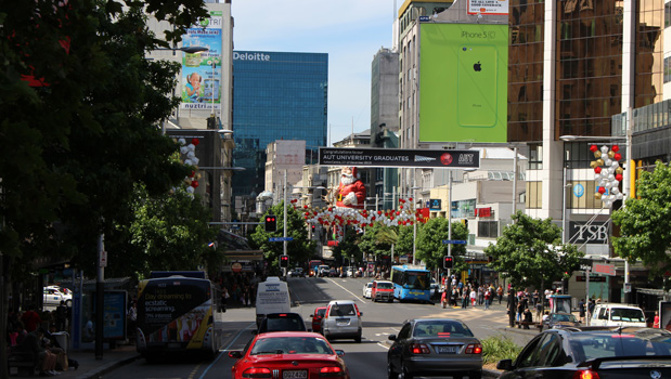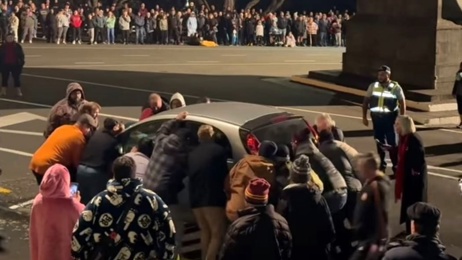Cherie Howie searches for the future of the Jekyll and Hyde that is Queen St.
It's the Queen's own street, in the Queen's own city - this stretch of Auckland's golden mile, or just over 1.7km to be exact.
Every day thousands trek its bluestone pavers, past tired old buildings and shiny new ones, past the massage hawkers by day, the drum-beating Hare Krishnas by night and the scattered beggars by all hours, past the queues outside Prada and Gucci and the chock-full souvenir shops selling "Made in Bangladesh" New Zealand T-shirts for $10.
Mayor Phil Goff calls Queen St not just Auckland's golden mile, but New Zealand's.
But the lifelong Aucklander takes his visitors elsewhere, where the central city experience is more public space than simply thoroughfare and shopping.
Auckland Council's six-year-old City Centre Master Plan lays out a 20-year vision for what it calls — north of the Victoria St intersection — the city centre's "engine room" but Goff says little has been actioned and Queen St needs change, among that permanent sections of shared space with pedestrians when trams return next decade.
/arc-anglerfish-syd-prod-nzme.s3.amazonaws.com/public/3U5FEX3VC5BSFPENZ2ASC7P5J4.jpg)
His planning committee chairman, councillor Chris Darby, who said he was often asked when Queen St would be pedestriansed and himself thought the street was in "drastic need" of revitalisation, said the master plan was being "refreshed" by council staff and would be presented to his committee at a workshop next month.
"Potentially it's looking at a no-cars environment for Queen St, it could be one or two blocks."
Plans were needed because trams could not just happen in isolation on Queen St - when they come it will be a "complete transformation" for the street.
"We don't call [the Queen St area] the engine room without good reason ... the opportunity is enormous."
'He thought it was dead'
At the start of Queen St, a few footsteps from the waterfront, future Auckland has brazenly shown its hand — the old Downtown Mall is gone and the $1 billion Commercial Bay retail, hotel and office tower development is changing the skyline above, just as the $3.4b City Rail Link will below.
At its end, those crossing the Karangahape Rd ridge on wheels woosh down into the Queen St valley, where apartment buildings and offices lean into the incline as a few hardy pedestrians inch up it.
In between is, well, everything.
Rows of Asian restaurants north of Mayoral Dr reflect the now two-decade old changing face of our biggest city, and sticky pavements outside McDonald's and Wendy's reflect a changing globe as multinationals ever-tighten their grip on the wallets of the world.
Big box chains have staked their claim around the street's centre and few family-owned businesses remain on the country's main drag — 138-year-old department store Smith & Caughey's is a prominent exception, while tucked-away the 84-year-old Marbecks music store is a less visible one.
And for all the concessions made for pedestrians, and the push for public transport — in the past decade wider footpaths and pedestrian-friendly traffic light sequencing have sent a strong message to those at the wheel and trams will return after 65 years by 2021 under a Government plan - motorists retain a strong presence.
All of the above means Queen St is noisy, tired, exciting, busy and frustrating.
Ask people on the street — visitors, locals or retailers — what they think and the answers are as varied as the thousands who frequent our most high-profile street every day.
/arc-anglerfish-syd-prod-nzme.s3.amazonaws.com/public/DMLOLZDR6JD4RLAACDWHVMYENM.jpg)
Twenty-two-year-old Daniel Kerr spoke for many when he described Queen St as "pretty good", but with room for improvement.
"It's the one place in Auckland there's always a place to eat. On Saturday night you can go anywhere."
But when his friend's father visited from the Philippines recently he asked Kerr why Queen St was so quiet.
"He thought it was dead."
City changing demands changing street
Watch this space, Heart of the City chief executive Viv Beck might have told Kerr's visitor.
The changes go beyond the planned Commercial Bay development on the waterfront.
Barely a block west is the upmarket Queen's Rise precinct, where 11 dining options opened in the newly refurbished QBE Centre three months ago.
The transformation of parts of our best-known street would endure, Beck said.
"It will continue to develop because the city itself is developing. More people are living in cities worldwide and there's definitely an appetite for investment, public and private."
An increased central city population also meant increased demand for amenities, and not just shopping but public spaces, she said.
/arc-anglerfish-syd-prod-nzme.s3.amazonaws.com/public/Q2UP3CFIRFE4LOPEC6HTNYB3AE.jpg)
Heart of the City, the business association for Auckland's city centre, also saw opportunity in the night-time economy.
Among their initiatives is a plan to upgrade the LED lights below Queen St's liquid ambers and nikau palms, with various colour options celebrating the festivals and occasions of the Kiwi calendar.
A growing city centre didn't come without challenges, Beck said.
Homelessness and other social issues must be tackled, and careful thought was needed around accessibility, she said.
The bottom of Queen St is a construction site for the City Rail Link, with narrow pathways kept open for pedestrians.
/arc-anglerfish-syd-prod-nzme.s3.amazonaws.com/public/7IJXS7IITJDGLFE36NH3KLC5VY.jpg)
But when the construction workers pack up their tools in 2020 the site outside Britomart will become a large pedestrian square with street furniture, space for events and pavement designs that depict waves coming to shore and the Waihorotiu Stream, which once ran into the harbour and still exists below Queen St, according to Auckland Council concept designs released in April.
It's all part of the changing city, a change that would take time, Beck said.
"We're evolving from a city that was very focused on cars to a city focused on public transport. We're in the middle of these changes and you can't just snap your fingers and have it change.
"We have to be realistic. There are challenges ... but I think we've got to be positive about the opportunities ahead."
'We're going to run out of room for the pedestrians'
That's Goff's mantra too.
His fondest memories of Queen St are the times it was closed to traffic for the Santa parades he attended as a child and the America's Cup victory parades he attended with his own children — and he wants to bring back partial and occasional closures with a view to easing the public into permanent pedestrianisation.
He puts numbers to Beck's talk of a changing city; city centre daily pedestrian numbers doubling to between 300,000 and 500,000 between 2012 and 2016, the city centre population rising from 9000 in 2001 to 53,000 in 2018 and 37,000 students travelling into the city centre every day.
"What that means is we've got to adapt the city to the changes happening there and in Queen St. We've got to make it more people focused, rather than transport focused.
"My vision is when we rip up the road for light rail ... there will be sections of it we'll permanently pedestrianise. Long-term with the population growth, the cruise ship visitors and the people working there, we're going to run out of room for the pedestrians."
/arc-anglerfish-syd-prod-nzme.s3.amazonaws.com/public/PGJ2BLG7ZFG7RAFC6MKFL4BN24.jpg)
Goff's wishes haven't gone to his council, but temporary road closures for events and shared space along some of Queen St's length, as well as publicly-accessible wifi for the whole city centre, were among future changes envisioned in the City Centre Master Plan Goff referred to.
Talk of giving cars the boot from at least some sections of Queen St will be music to the ears of Matt Lawrie, director transport and urban issues lobby Greater Auckland.
Leave the street for pedestrians, public transport and, at certain hours, deliveries only, Lawrie said.
"There's no loading docks between Aotea Square and the bottom of Queen St ... there's not a single reason for a car to be on Queen St."
Not everyone is ready to banish cars to the surrounding streets.
AA infrastructure principal advisor Barney Irvine said Auckland AA members were keen to see more pedestrian-focused spaces in the central business district, but getting into, and through, the central city in vehicles was still important to them – whether for work or pleasure.
An AA survey of Auckland members last year found 50 per cent of respondents had never heard of the idea of pedestrianising Queen St, and 38 per cent were only vaguely aware of it.
/arc-anglerfish-syd-prod-nzme.s3.amazonaws.com/public/WDNNRURM5ZBLPM6IH6XNAWRULI.jpg)
Goff was confident that attitudes towards booting cars out of the city centre, political suicide a few years ago, were changing.
More than half of people coming into the city walked, biked or used public transport and shared spaces had proved positive in places such as Fort St, where retail spending increased by 47 per cent after cars and pedestrians began sharing the road, he said.
The council doing its bit to improve public spaces, from better public transport to more room to move, to cleaner streets, would also encourage big business to see a future in the city.
That would have its own effect of improving Queen St, he said.
"Keep the best of your history ... [but] instead of drab old buildings we'll start to get iconic buildings architecturally designed to be outstanding. Auckland is New Zealand's only potentially truly global city. We've got to encourage that with this sort of investment in Auckland."
/arc-anglerfish-syd-prod-nzme.s3.amazonaws.com/public/G4FKVQ6NB5CCTMYPWDNMSA7KNM.jpg)
The council-Government Housing First programme to support homeless into permanent accommodation was also key to solving social problems that could blight busy locations such as Queen St.
For now, Goff would continue to take his visitors to Wynyard Quarter and Freyberg Pl, where they can watch kids play, have a drink and relax. That will change.
"Queen St is not yet really special ... but I absolutely believe Queen St can be an extension of what you get in those places."
Future bright - top architect
Architect and urbanist Julie Stout reckons Queen St is already a good urban environment.
And the future was looking even brighter for the director of Stout Dodd Architects, who is also chairwoman of Urban Auckland, a lobby group focused on quality design of the city and development of the waterfront.
"It's packed on the weekend — it never used to be. [Now] it's about changing the balance."
/arc-anglerfish-syd-prod-nzme.s3.amazonaws.com/public/QPUDVHU5DBETVCV5QDZAYNLP6U.jpg)
That meant gradually getting cars out to make way for the "inevitable" pedestrianisation.
She wasn't convinced by any claims the street was dour or tired. Rain more days than not meant this is the season for gloom in Auckland.
But the leaves will soon return to the trees and summer will follow, and in a few more summers Queen St will be a different place, Stout said.
"Queen Street probably will in 10 years time be a really first-class avenue. It's a street right now, but it will become an avenue."
What do Queen St users think?
Beverly Lim, 25, retail worker, Auckland
/arc-anglerfish-syd-prod-nzme.s3.amazonaws.com/public/HOTMFA5MHRENFCJDPRB2SO2ABE.jpg)
I've become a bloody unofficial tourist information centre. [Visitors] say, 'Well, Queen St - is this it?', I say, 'No, you have to go to Mt Eden, even Mission Bay'. We need to give them stuff to do and places to relax and not feel like a tourist. Do you want to see New Zealand, do you want to eat New Zealand food? Then get off Queen St. I also like to tell people to go to K Rd, because it's more bohemian and honest.
Tomas Rikona, 52, beggar and former chef, Auckland Central
/arc-anglerfish-syd-prod-nzme.s3.amazonaws.com/public/E4R6MQ3SVNBU5ND2SSZYFNMYJM.jpg)
I quite like the feel of Auckland now. It's got a more modern feel about it. In the 70s and 80s it was kind of a dodgy place to hang out, even during the day. The police are really good these days. I wish [the council] would stop messing around with Aotea Square. It seems like a make-work thing and it's costing the ratepayers. It's been changed about four times that I can remember.
Sanchre Scott, 43, mum, North Shore
/arc-anglerfish-syd-prod-nzme.s3.amazonaws.com/public/QHDHUUHDMZA4TIST52ILSDNOHE.jpg)
I enjoy Queen St. There's quite a buzz and a good mix of shops along the drag. There's a few homeless people who hang out on Queen St which brings it down but what city doesn't have that?
Lauren Johnson, 32, Durban
I think it's quite nice. It's clean, there's nice shops, people are friendly, there's good security. I wouldn't go into [the main street] in Durban, so it's an experience.
Roger Marbeck, 62, Marbecks music store owner, Auckland
/arc-anglerfish-syd-prod-nzme.s3.amazonaws.com/public/NPV23Q2SXZFCFP3VR7LI5M464A.jpg)
The council need to yank their socks up. It looks tired and a lot of it is maintenance. I think it could be slicker. You've got a great bunch of businesses and they spend a lot [on rates]. Auckland's still a small city, they've got to be very careful not to expand or close off areas for pedestrians only that are just going to create big vacuums.
Carol Green, 46, Te Atatū
/arc-anglerfish-syd-prod-nzme.s3.amazonaws.com/public/7XMDD723LFC5BMHULRV5EMJS5Q.jpg)
There's a bit missing from Mayoral Dr to K Rd. There's nothing to stop at, like destination shops or cafes. It feels like a place you use to go from one place to another, rather than stopping.
Simon Enderby, 40, Te Atatū
From Mayoral Dr to the bottom of Queen St should be pedestrianised ... because there's enough business and people around there to walk and shop.










